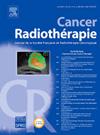Overcoming the limits of pediatric brain tumor radiotherapy: The use of preclinical 3D models
IF 1.5
4区 医学
Q4 ONCOLOGY
引用次数: 0
Abstract
Radiotherapy (RT) is an integral part of managing pediatric brain tumors, yet many patients develop tumor radioresistance, leading to recurrence and poor clinical outcomes. In addition, neurocognitive impairment is a common long-term side effect of RT, significantly impairing quality of life. Indeed, increasing evidence suggests that the developing child's brain is particularly vulnerable to the neurotoxic effects of ionizing radiation. Consequently, developing novel preclinical models is crucial for studying radiation's impact on normal brain tissue and predicting patient-specific responses to RT, enabling the development of personalized therapies combined with RT. However, this area remains underexplored, primarily due to the transfer of results gathered from in vitro tumor models from adults to pediatric entities while the location and molecular characteristics of the brain tumor differ. Recent years have seen the emergence of patient-specific 3D in vitro models, which have been established for entities including glioblastoma and medulloblastoma. These models better mimic primary parenteral tumors more closely in their histological, transcriptional, and mutational characteristics, thus approximating their intratumoral heterogeneity more accurately than conventional 2D-models. In this review, we presented the main limits of pediatric brain tumor radiotherapy, including mechanisms of radioresistance, associated tumor relapse, and the side effects of irradiation on the central nervous system. We also conducted an exhaustive review to identify studies utilizing basic or advanced 3D models of pediatric brain tumors combined with irradiation and discussed how these models can overcome the limitations of RT.
克服小儿脑肿瘤放射治疗的局限性:使用临床前三维模型。
放疗(RT)是治疗小儿脑肿瘤不可或缺的一部分,但许多患者会产生肿瘤放射抵抗,导致复发和不良的临床疗效。此外,神经认知障碍是 RT 常见的长期副作用,严重影响生活质量。事实上,越来越多的证据表明,发育中的儿童大脑特别容易受到电离辐射的神经毒性影响。因此,开发新的临床前模型对于研究辐射对正常脑组织的影响和预测患者对 RT 的特异性反应至关重要,这样才能开发出结合 RT 的个性化疗法。然而,这一领域仍未得到充分探索,主要原因是将从成人体外肿瘤模型收集到的结果转移到儿童实体,而脑肿瘤的位置和分子特征各不相同。近年来出现了患者特异性三维体外模型,已建立的实体包括胶质母细胞瘤和髓母细胞瘤。与传统的二维模型相比,这些模型在组织学、转录和突变特征方面更接近于原发性实体瘤,从而更准确地接近瘤内异质性。在这篇综述中,我们介绍了小儿脑肿瘤放射治疗的主要局限性,包括放射耐药机制、相关肿瘤复发以及照射对中枢神经系统的副作用。我们还进行了详尽的综述,以确定利用小儿脑肿瘤的基本或高级三维模型结合照射的研究,并讨论了这些模型如何克服 RT 的局限性。
本文章由计算机程序翻译,如有差异,请以英文原文为准。
求助全文
约1分钟内获得全文
求助全文
来源期刊

Cancer Radiotherapie
医学-核医学
CiteScore
2.20
自引率
23.10%
发文量
129
审稿时长
63 days
期刊介绍:
Cancer/radiothérapie se veut d''abord et avant tout un organe francophone de publication des travaux de recherche en radiothérapie. La revue a pour objectif de diffuser les informations majeures sur les travaux de recherche en cancérologie et tout ce qui touche de près ou de loin au traitement du cancer par les radiations : technologie, radiophysique, radiobiologie et radiothérapie clinique.
 求助内容:
求助内容: 应助结果提醒方式:
应助结果提醒方式:


